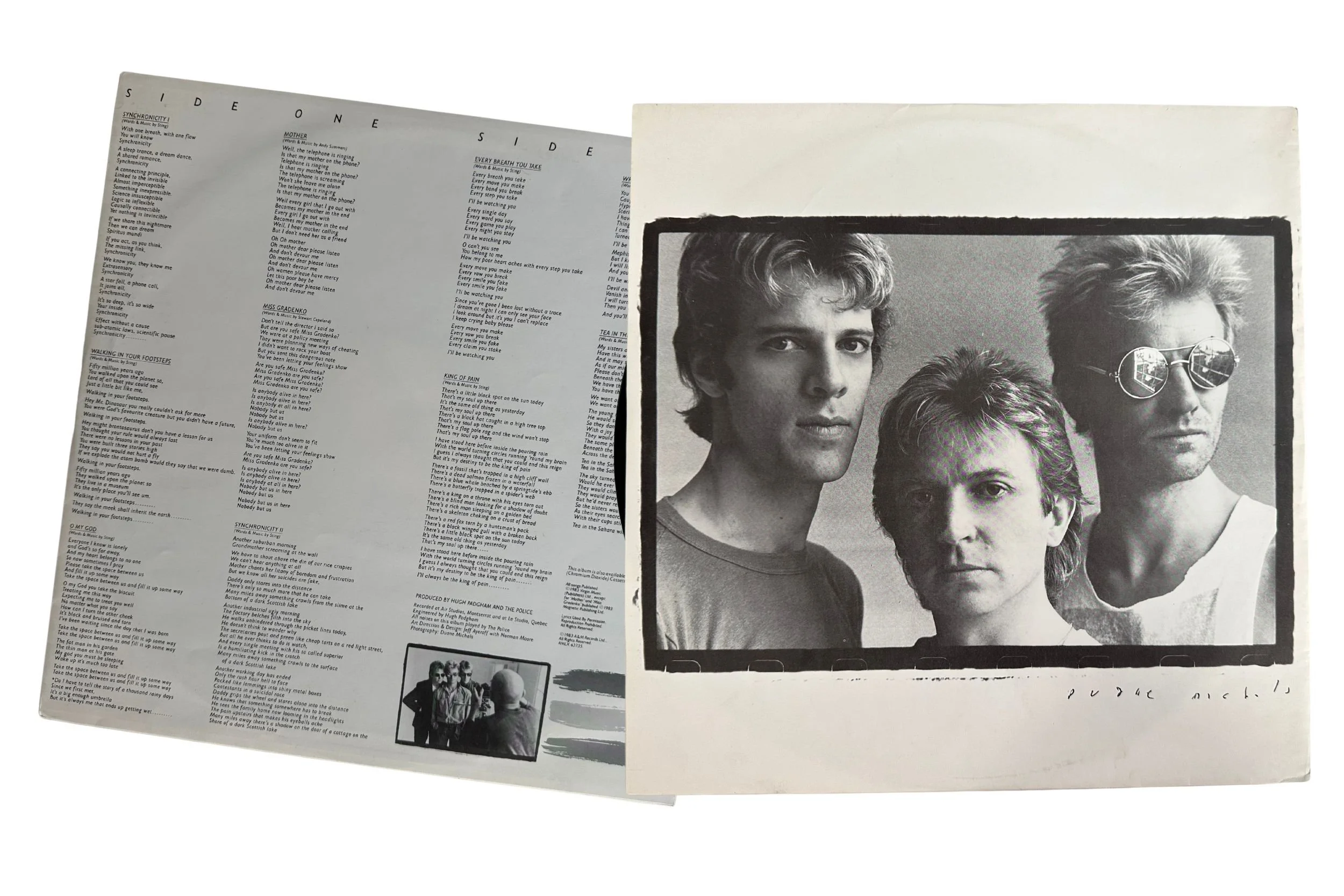Synchronicity Album Review: The Police in Paradise and in Pieces
Released in 1983, Synchronicity became both the Police’s greatest triumph and their final studio album. Recorded at George Martin’s AIR Studios in Montserrat under strained conditions, it remains a fascinating paradox: an album shaped by personal conflict but remembered as a near-perfect collection of songs.
The Backstory: Pressure and Tension in Paradise
By the end of 1982, the Police were one of the biggest bands in the world. Ghost in the Machine had been a major hit, a gruelling 100-night world tour had cemented their status, and expectations for the follow-up were sky-high. Behind the scenes, however, the band was unravelling.
Sting, Andy Summers, and Stewart Copeland were dealing with broken marriages, the grind of tax exile, and above all, creative friction. Sting had become the dominant songwriter — a key factor in their success but also the main source of resentment. For Summers and Copeland, it increasingly felt like Sting’s band, not their band.
Hoping for inspiration, they returned to George Martin’s AIR Studios on the Caribbean island of Montserrat. The tropical setting had already yielded results on their last album, but this time the mood was very different. Each member recorded their parts in separate rooms, overdubbing at different times, and often avoiding each other entirely. It was hardly a model of synchronicity.
What Does Synchronicity Mean?
The title of the album comes from the psychologist Carl Jung’s theory of “synchronicity” — the idea that events can be meaningfully connected without a clear cause-and-effect relationship. Sting, who was reading Jung at the time, used the concept as a lens for the album.
In his book, ‘Lyrics by Sting’ he writes of the inspiration, “wrote a lot of these songs in Golden Eye, Ian Fleming’s old home on the north shore of Jamaica. Britain had gone to war with Argentina over the Falklands. Young men were dying in the freezing waters of the South Atlantic, while I was gazing at sunspots on a clifftop overlooking the Caribbean. During this time I read Arthur Koestler, whose work in turn led me to Carl Jung. The title of the album refers to Jung’s concept of meaningful coincidence”
Sting. Lyrics (p. 94). (Function). Kindle Edition. On Synchronicity, the Police play with this tension: songs that seem unconnected — from prehistoric extinction (Walking in Your Footsteps) to doomed love (Tea in the Sahara) — find themselves bound together by mood, theme, and timing. The irony, of course, is that while the music achieved a sense of unity, the band itself was falling apart.
The Album Review: Track by Track
How then, from such division, did the Police deliver their most coherent work? Synchronicity opens with urgency and never really lets go.
Synchronicity I – a frantic, tight burst of energy that sets the tone.
Walking in Your Footsteps – a moody meditation with tribal rhythms, its lyrics comparing dinosaurs to humanity.
Tea in the Sahara – a haunting closer inspired by Paul Bowles’ novel The Sheltering Sky.
The chart hits came thick and fast:
King of Pain – a perfect balance of melancholy and melody.
Wrapped Around Your Finger – subtle, mesmerising, a masterclass in atmosphere.
Every Breath You Take – the album’s juggernaut single. The video makes it look like a Sting solo track, but it remains one of the most recognisable songs of the 1980s.
Contractual obligation allowed Andy Summers a track of his own — the off-kilter Mother. For some, it’s a brave experiment; for others (myself included) it’s the weakest cut.
The Synchronicity Album Cover and Its Symbolism
The cover of Synchronicity is as striking as the music itself. Designed by graphic artist Jeff Ayeroff and photographer Duane Michals, it features black-and-white portraits of Sting, Andy Summers, and Stewart Copeland set against bold brushstrokes of red, yellow, and blue.
The primary colours weren’t chosen at random. They suggest separation and unity all at once — three bold strokes keeping the band apart, yet forcing them into the same frame. It’s a visual echo of Jung’s concept of synchronicity: events or elements that seem unconnected, yet take on meaning when viewed together.
Part of the randomness of the sleeve came directly from Sting’s idea. He suggested that each band member should choose his own imagery for the photos, without consulting the others. Sting selected the American Museum of Natural History in New York, posing among skeletons — including dinosaurs — which neatly tied into the prehistoric themes of Walking in Your Footsteps. The result is a sleeve that feels fractured but strangely coherent, much like the album itself.
The inside sleeve with lyric sheet
The Synchronicity artwork has since become iconic, instantly recognisable on record shelves and perfectly mirroring the paradox of the Police at their creative peak and personal breaking point.
Reception and Legacy
Upon release in June 1983, Synchronicity was a phenomenon. It topped the charts worldwide, earned multiple Grammy Awards, and powered another massive tour. The Police had reached the summit — only to break apart at the peak.
It would prove their final studio album. Sting soon embarked on a solo career, while the Police reunited only for tours and one-off events. The Montserrat sessions left their mark, though: after wrapping the record, Sting stayed on the island briefly, long enough to sing the famous “I want my MTV” line on Dire Straits’ Money for Nothing, which was being recorded next in the studio.
Why Synchronicity Endures
Synchronicity is both a time capsule and a timeless record. It captures the Police at full creative power, even as the personal bonds holding them together were disintegrating. The combination of pop hooks, literate lyrics, and studio precision make it one of the defining albums of the 1980s.
Born of tension, recorded in isolation, and yet delivered with remarkable unity — it remains a classic, and a fitting end to one of the most successful bands of the era.
